Investigating the Association between Streetscapes and Mental Health in Zhanjiang, China: Using Baidu Street View Images and Deep Learning
Abstract
1. Introduction
2. Materials and Methods
2.1. Study Areas
2.2. Data
2.3. Methods
3. Results
3.1. Spatial Patterns of GVI in the Whole Study Area
3.2. Spatial Patterns of Streets Enclosure in the Whole Study Area
3.3. Analysis of the Association between Streetscape Features and Mental Health at Different Buffer Distances
4. Discussion
5. Conclusions
Author Contributions
Funding
Institutional Review Board Statement
Informed Consent Statement
Data Availability Statement
Conflicts of Interest
References
- Patil, R.R. Urbanization as a Determinant of Health: A Socioepidemiological Perspective. Soc. Work. Public Health 2014, 29, 335–341. [Google Scholar] [CrossRef] [PubMed]
- Zhang, W. A forecast analysis on world population and urbanization process. Environ. Dev. Sustain. 2008, 10, 717–730. [Google Scholar] [CrossRef]
- Wei, H.; Li, L.; Nian, M. China’s Urbanization Strategy and Policy During the 14th Five-Year Plan Period. Chin. J. Urban Environ. Stud. 2021, 09, 2150002. [Google Scholar] [CrossRef]
- Chen, J.; Guo, F.; Wu, Y. One decade of urban housing reform in China: Urban housing price dynamics and the role of migration and urbanization, 1995–2005. Habitat Int. 2011, 35, 1–8. [Google Scholar] [CrossRef]
- Yu, A.T.W.; Wu, Y.; Zheng, B.; Zhang, X.; Shen, L. Identifying risk factors of urban-rural conflict in urbanization: A case of China. Habitat Int. 2014, 44, 177–185. [Google Scholar] [CrossRef]
- Gong, P.; Liang, S.; Carlton, E.J.; Jiang, Q.; Wu, J.; Wang, L.; Remais, J.V. Urbanisation and health in China. Lancet 2012, 379, 843–852. [Google Scholar] [CrossRef]
- Zhu, Y.-G.; Ioannidis, J.P.A.; Li, H.; Jones, K.C.; Martin, F.L. Understanding and Harnessing the Health Effects of Rapid Urbanization in China. Environ. Sci. Technol. 2011, 45, 5099–5104. [Google Scholar] [CrossRef]
- Chen, J.; Chen, S.; Landry, P.F. Urbanization and Mental Health in China: Linking the 2010 Population Census with a Cross-Sectional Survey. Int. J. Environ. Res. Public Health 2015, 12, 9012–9024. [Google Scholar] [CrossRef]
- Li, J.; Liu, Z. Housing stress and mental health of migrant populations in urban China. Cities 2018, 81, 172–179. [Google Scholar] [CrossRef]
- Charlson, F.J.; Baxter, A.J.; Cheng, H.G.; Shidhaye, R.; Whiteford, H.A. The burden of mental, neurological, and substance use disorders in China and India: A systematic analysis of community representative epidemiological studies. Lancet 2016, 388, 376–389. [Google Scholar] [CrossRef]
- Asgarzadeh, M.; Koga, T.; Hirate, K.; Farvid, M.; Lusk, A. Investigating oppressiveness and spaciousness in relation to building, trees, sky and ground surface: A study in Tokyo. Landsc. Urban Plan. 2014, 131, 36–41. [Google Scholar] [CrossRef]
- Harvey, C.; Aultman-Hall, L.; Hurley, S.E.; Troy, A. Effects of skeletal streetscape design on perceived safety. Landsc. Urban Plan. 2015, 142, 18–28. [Google Scholar] [CrossRef]
- Wolf, K.L. Business District Streetscapes, Trees, and Consumer Response. J. For. 2005, 103, 396–400. [Google Scholar]
- Ki, D.; Lee, S. Analyzing the effects of Green View Index of neighborhood streets on walking time using Google Street View and deep learning. Landsc. Urban Plan. 2021, 205, 103920. [Google Scholar] [CrossRef]
- Li, X.; Zhang, C.; Li, W.; Ricard, R.; Meng, Q.; Zhang, W. Assessing street-level urban greenery using Google Street View and a modified green view index. Urban For. Urban Green. 2015, 14, 675–685. [Google Scholar] [CrossRef]
- Liu, Y.; Wang, R.; Grekousis, G.; Liu, Y.; Yuan, Y.; Li, Z. Neighbourhood greenness and mental wellbeing in Guangzhou, China: What are the pathways? Landsc. Urban Plan. 2019, 190, 103602. [Google Scholar] [CrossRef]
- Yang, Y.; He, D.; Gou, Z.; Wang, R.; Liu, Y.; Lu, Y. Association between street greenery and walking behavior in older adults in Hong Kong. Sustain. Cities Soc. 2019, 51, 101747. [Google Scholar] [CrossRef]
- Wang, R.; Helbich, M.; Yao, Y.; Zhang, J.; Liu, P.; Yuan, Y.; Liu, Y. Urban greenery and mental wellbeing in adults: Cross-sectional mediation analyses on multiple pathways across different greenery measures. Environ. Res. 2019, 176, 108535. [Google Scholar] [CrossRef]
- Forrest, R.; Kearns, A. Social cohesion, social capital and the neighbourhood. Urban Stud. 2001, 38, 2125–2143. [Google Scholar] [CrossRef]
- Kaplan, S. The restorative benefits of nature: Toward an integrative framework. J. Environ. Psychol. 1995, 15, 169–182. [Google Scholar] [CrossRef]
- Ulrich, R.S.; Simons, R.F.; Losito, B.D.; Fiorito, E.; Miles, M.A.; Zelson, M. Stress recovery during exposure to natural and urban environments. J. Environ. Psychol. 1991, 11, 201–230. [Google Scholar] [CrossRef]
- Hunter, R.F.; Christian, H.; Veitch, J.; Astell-Burt, T.; Hipp, J.A.; Schipperijn, J. The impact of interventions to promote physical activity in urban green space: A systematic review and recommendations for future research. Soc. Sci. Med. 2015, 124, 246–256. [Google Scholar] [CrossRef] [PubMed]
- Ziersch, A.M.; Baum, F.E.; MacDougall, C.; Putland, C. Neighbourhood life and social capital: The implications for health. Social Sci. Med. 2005, 60, 71–86. [Google Scholar] [CrossRef] [PubMed]
- Ta, N.; Li, H.; Chai, Y.; Wu, J. The impact of green space exposure on satisfaction with active travel trips. Transp. Res. Part D Transp. Environ. 2021, 99, 103022. [Google Scholar] [CrossRef]
- Yue, Y.; Yang, D.; Van Dyck, D. Urban greenspace and mental health in Chinese older adults: Associations across different greenspace measures and mediating effects of environmental perceptions. Health Place 2022, 76, 102856. [Google Scholar] [CrossRef]
- Ewing, R.; Handy, S. Measuring the Unmeasurable: Urban Design Qualities Related to Walkability. J. Urban Des. 2009, 14, 65–84. [Google Scholar] [CrossRef]
- Chapman, L.; Thornes, J.E. Real-Time Sky-View Factor Calculation and Approximation. J. Atmos. Ocean. Technol. 2004, 21, 730–741. [Google Scholar] [CrossRef]
- Maas, J.; Verheij, R.A.; Groenewegen, P.P.; de Vries, S.; Spreeuwenberg, P. Green space, urbanity, and health: How strong is the relation? J. Epidemiol. Community Health 2006, 60, 587. [Google Scholar] [CrossRef]
- Hwang, R.-L.; Lin, T.-P.; Matzarakis, A. Seasonal effects of urban street shading on long-term outdoor thermal comfort. Build. Environ. 2011, 46, 863–870. [Google Scholar] [CrossRef]
- Lin, T.-P.; Tsai, K.-T.; Hwang, R.-L.; Matzarakis, A. Quantification of the effect of thermal indices and sky view factor on park attendance. Landsc. Urban Plan. 2012, 107, 137–146. [Google Scholar] [CrossRef]
- Li, X.; Santi, P.; Courtney, T.K.; Verma, S.K.; Ratti, C. Investigating the association between streetscapes and human walking activities using Google Street View and human trajectory data. Trans. GIS 2018, 22, 1029–1044. [Google Scholar] [CrossRef]
- Baran, P.K.; Tabrizian, P.; Zhai, Y.; Smith, J.W.; Floyd, M.F. An exploratory study of perceived safety in a neighborhood park using immersive virtual environments. Urban For. Urban Green. 2018, 35, 72–81. [Google Scholar] [CrossRef]
- Yin, L.; Wang, Z. Measuring visual enclosure for street walkability: Using machine learning algorithms and Google Street View imagery. Appl. Geogr. 2016, 76, 147–153. [Google Scholar] [CrossRef]
- Rundle, A.G.; Bader, M.D.M.; Richards, C.A.; Neckerman, K.M.; Teitler, J.O. Using Google Street View to Audit Neighborhood Environments. Am. J. Prev. Med. 2011, 40, 94–100. [Google Scholar] [CrossRef]
- Zhang, F.; Zhou, B.; Liu, L.; Liu, Y.; Fung, H.H.; Lin, H.; Ratti, C. Measuring human perceptions of a large-scale urban region using machine learning. Landsc. Urban Plan. 2018, 180, 148–160. [Google Scholar] [CrossRef]
- Chen, X.; Meng, Q.; Hu, D.; Zhang, L.; Yang, J. Evaluating Greenery around Streets Using Baidu Panoramic Street View Images and the Panoramic Green View Index. Forests 2019, 10, 1109. [Google Scholar] [CrossRef]
- Cheng, X.-L.; Padullés Cubino, J.; Balfour, K.; Zhu, Z.-X.; Wang, H.-F. Drivers of spontaneous and cultivated species diversity in the tropical city of Zhanjiang, China. Urban For. Urban Green. 2022, 67, 127428. [Google Scholar] [CrossRef]
- Cheng, X.-L.; Nizamani, M.M.; Jim, C.Y.; Balfour, K.; Da, L.-J.; Qureshi, S.; Zhu, Z.-X.; Wang, H.-F. Using SPOT Data and FRAGSTAS to Analyze the Relationship between Plant Diversity and Green Space Landscape Patterns in the Tropical Coastal City of Zhanjiang, China. Remote Sens. 2020, 12, 3477. [Google Scholar] [CrossRef]
- Hu, S.; Lin, D.; Pan, M.; Ma, S. Mechanism Construction of Zhanjiang to Build an Important Development Pole of Coastal Economic Belt. J. Simul. 2021, 9, 113. [Google Scholar]
- Qin, X.; Hsieh, C.-R. Understanding and Addressing the Treatment Gap in Mental Healthcare: Economic Perspectives and Evidence From China. INQUIRY J. Health Care Organ. Provis. Financ. 2020, 57, 0046958020950566. [Google Scholar] [CrossRef]
- Chen, J.; Zhou, C.; Li, F. Quantifying the green view indicator for assessing urban greening quality: An analysis based on Internet-crawling street view data. Ecol. Indic. 2020, 113, 106192. [Google Scholar] [CrossRef]
- Yu, X.; Zhao, G.; Chang, C.; Yuan, X.; Heng, F. BGVI: A New Index to Estimate Street-Side Greenery Using Baidu Street View Image. Forests 2019, 10, 3. [Google Scholar] [CrossRef]
- Long, Y.; Liu, L. How green are the streets? An analysis for central areas of Chinese cities using Tencent Street View. PLoS ONE 2017, 12, e0171110. [Google Scholar] [CrossRef] [PubMed]
- Ojeda Sánchez, C.; Segú-Tell, J.; Gomez-Barroso, D.; Pardo Romaguera, E.; Ortega-García, J.A.; Ramis, R. Urban green spaces and childhood leukemia incidence: A population-based case-control study in Madrid. Environ. Res. 2021, 202, 111723. [Google Scholar] [CrossRef]
- Qi, M.; Hankey, S. Using Street View Imagery to Predict Street-Level Particulate Air Pollution. Environ. Sci. Technol. 2021, 55, 2695–2704. [Google Scholar] [CrossRef]
- WHO. The ICD-10 Classification of Mental and Behavioural Disorders; World Health Organization: Geneva, Switzerland, 1993.
- Li, X.; Ratti, C.; Seiferling, I. Quantifying the shade provision of street trees in urban landscape: A case study in Boston, USA, using Google Street View. Landsc. Urban Plan. 2018, 169, 81–91. [Google Scholar] [CrossRef]
- Long, J.; Shelhamer, E.; Darrell, T.; Berkeley, U. Fully Convolutional Networks for Semantic Segmentation. In Proceedings of the IEEE Conference on Computer Vision and Pattern Recognition, Boston, MA, USA, 7–12 June 2015. [Google Scholar]
- Yao, Y.; Liang, Z.; Yuan, Z.; Liu, P.; Bie, Y.; Zhang, J.; Wang, R.; Wang, J.; Guan, Q. A human-machine adversarial scoring framework for urban perception assessment using street-view images. Int. J. Geogr. Inf. Sci. 2019, 33, 2363–2384. [Google Scholar] [CrossRef]
- Hasani, J.; Erfanpoor, S.; Rajabi, A.; Barzegar, A.; Khodadoost, M.; Afkar, M.; Nazari, S.S.H. Spatial analysis of mortality rate of pedestrian accidents in Iran during 2012–2013. Traffic Inj. Prev. 2019, 20, 636–640. [Google Scholar] [CrossRef]
- Lee, M.; Khattak, A.J. Case Study of Crash Severity Spatial Pattern Identification in Hot Spot Analysis. Transp. Res. Rec. 2019, 2673, 684–695. [Google Scholar] [CrossRef]
- Mitchell, A.; Griffin, L.S. The Esri Guide to GIS Analysis; ESRI Press: Redlands, CA, USA, 2005; Volume 2. [Google Scholar]
- Beyer, K.M.M.; Kaltenbach, A.; Szabo, A.; Bogar, S.; Nieto, F.J.; Malecki, K.M. Exposure to Neighborhood Green Space and Mental Health: Evidence from the Survey of the Health of Wisconsin. Int. J. Environ. Res. Public Health 2014, 11, 3453–3472. [Google Scholar] [CrossRef]
- Richardson, E.; Pearce, J.; Mitchell, R.; Day, P.; Kingham, S. The association between green space and cause-specific mortality in urban New Zealand: An ecological analysis of green space utility. BMC Public Health 2010, 10, 240. [Google Scholar] [CrossRef] [PubMed]
- Akpinar, A.; Barbosa-Leiker, C.; Brooks, K.R. Does green space matter? Exploring relationships between green space type and health indicators. Urban For. Urban Green. 2016, 20, 407–418. [Google Scholar] [CrossRef]
- Richardson, E.A.; Mitchell, R.; Hartig, T.; Vries, S.d.; Astell-Burt, T.; Frumkin, H. Green cities and health: A question of scale? J. Epidemiol. Community Health 2012, 66, 160. [Google Scholar] [CrossRef] [PubMed]
- Picavet, H.S.J.; Milder, I.; Kruize, H.; de Vries, S.; Hermans, T.; Wendel-Vos, W. Greener living environment healthier people?: Exploring green space, physical activity and health in the Doetinchem Cohort Study. Prev. Med. 2016, 89, 7–14. [Google Scholar] [CrossRef] [PubMed]
- Mitchell, R.; Popham, F. Greenspace, urbanity and health: Relationships in England. J. Epidemiol. Community Health 2007, 61, 681. [Google Scholar] [CrossRef] [PubMed]
- Wang, R.; Lu, Y.; Zhang, J.; Liu, P.; Yao, Y.; Liu, Y. The relationship between visual enclosure for neighbourhood street walkability and elders’ mental health in China: Using street view images. J. Transp. Health 2019, 13, 90–102. [Google Scholar] [CrossRef]
- Desai, N.G.; Tiwari, S.C.; Nambi, S.; Shah, B.; Singh, R.A.; Kumar, D.; Trivedi, J.K.; Palaniappan, V.; Tripathi, A.; Pali, C.; et al. Urban mental health services in India: How complete or incomplete? Indian J. Psychiatry 2004, 46, 195–212. [Google Scholar]

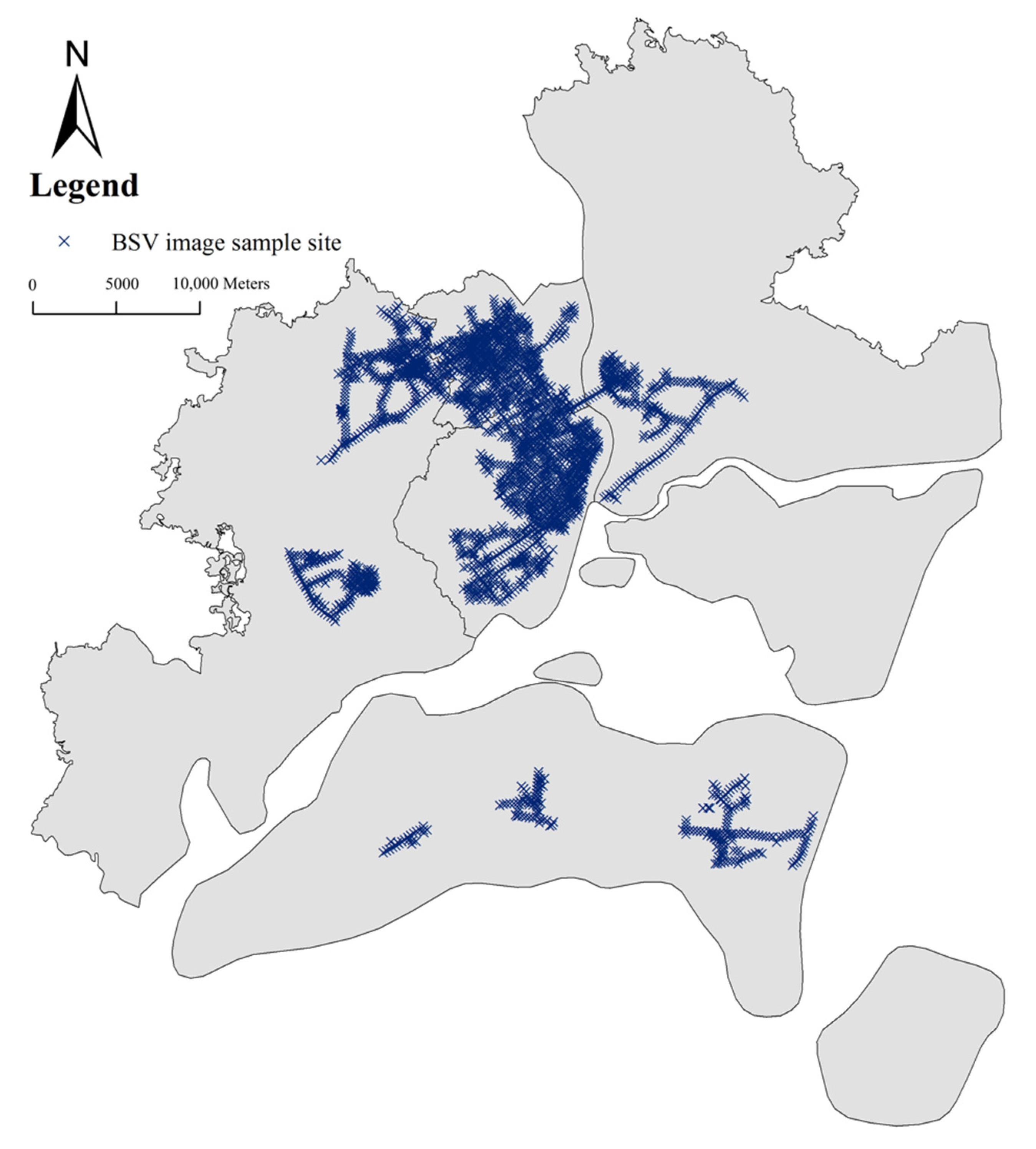



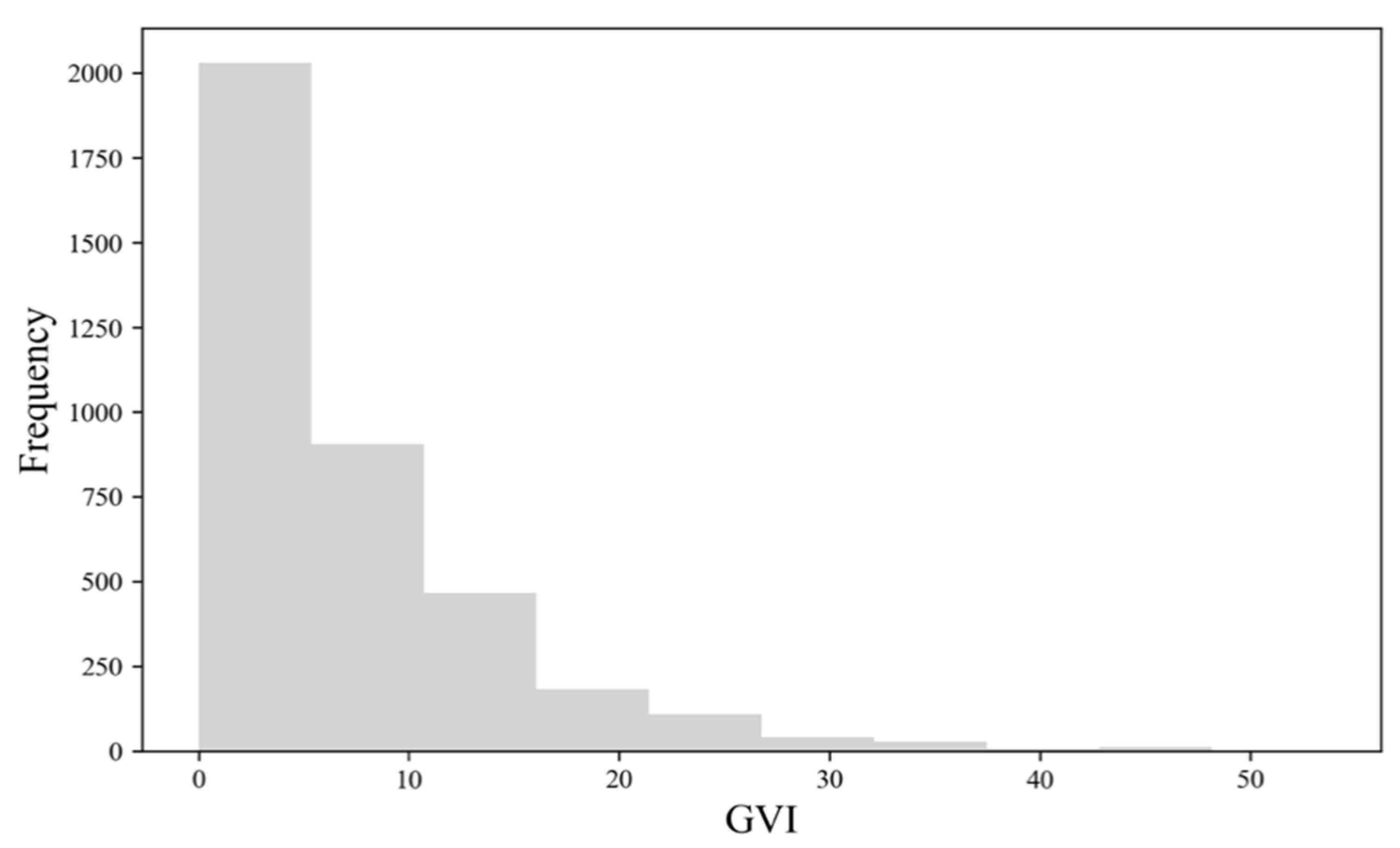
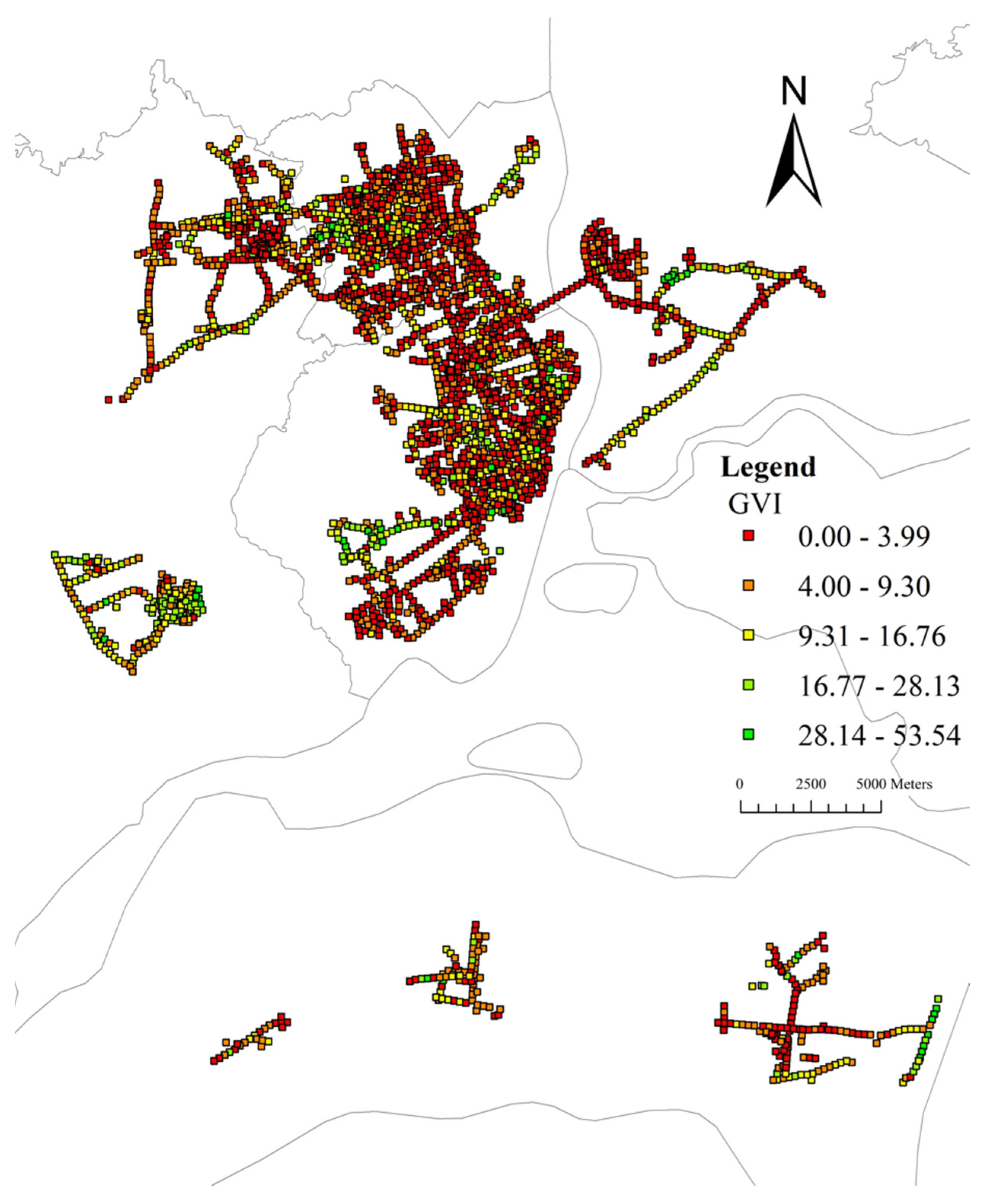
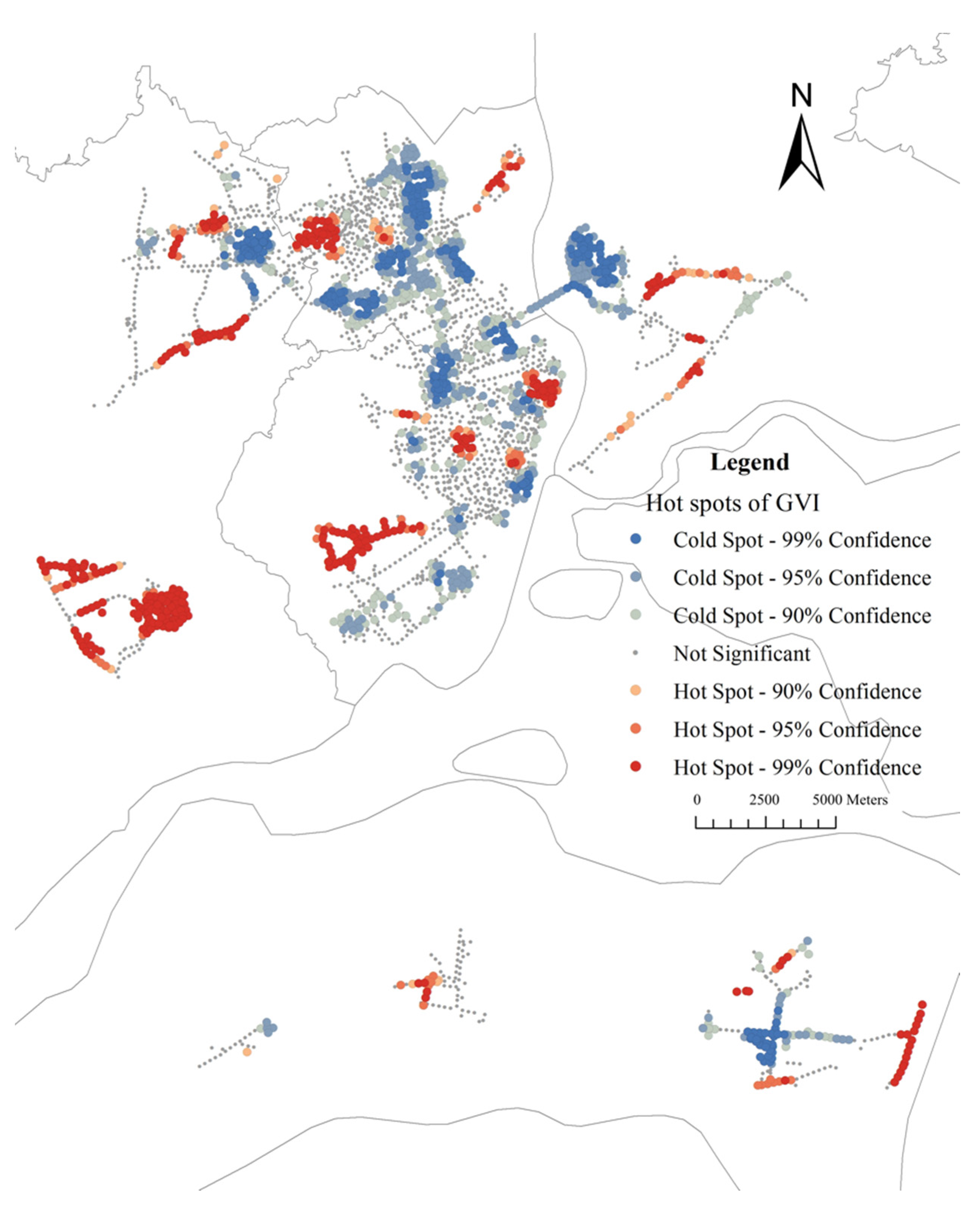
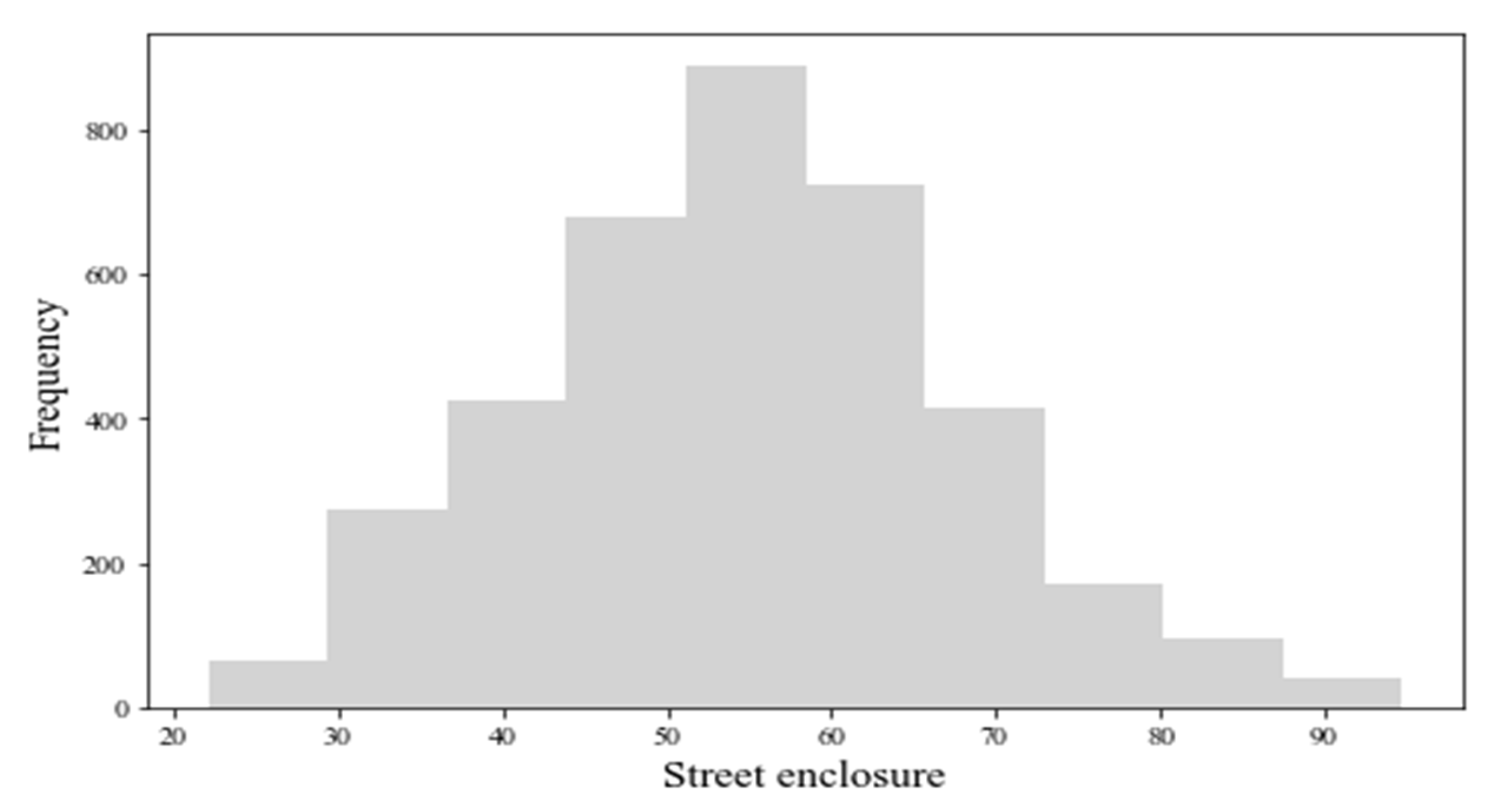
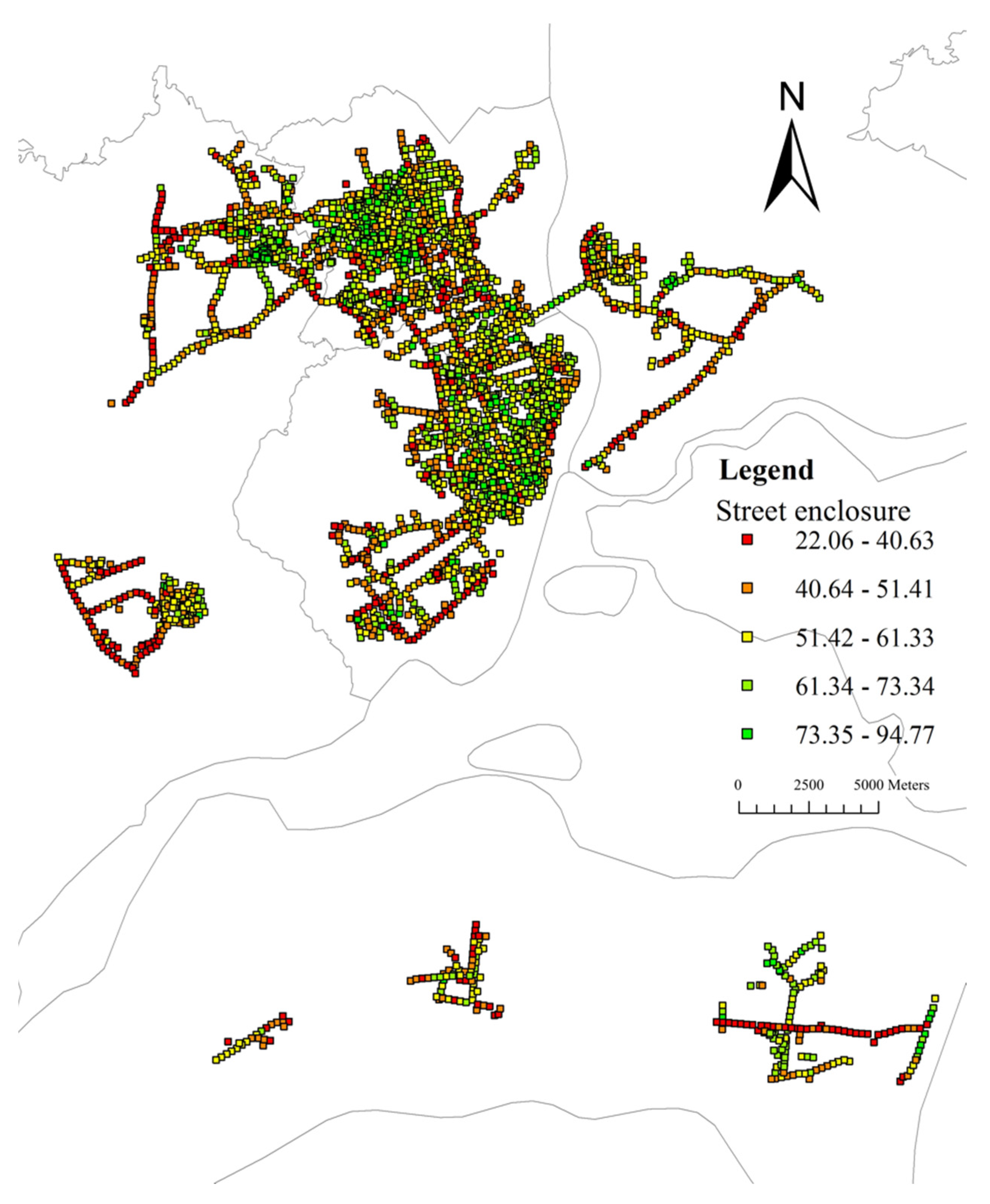
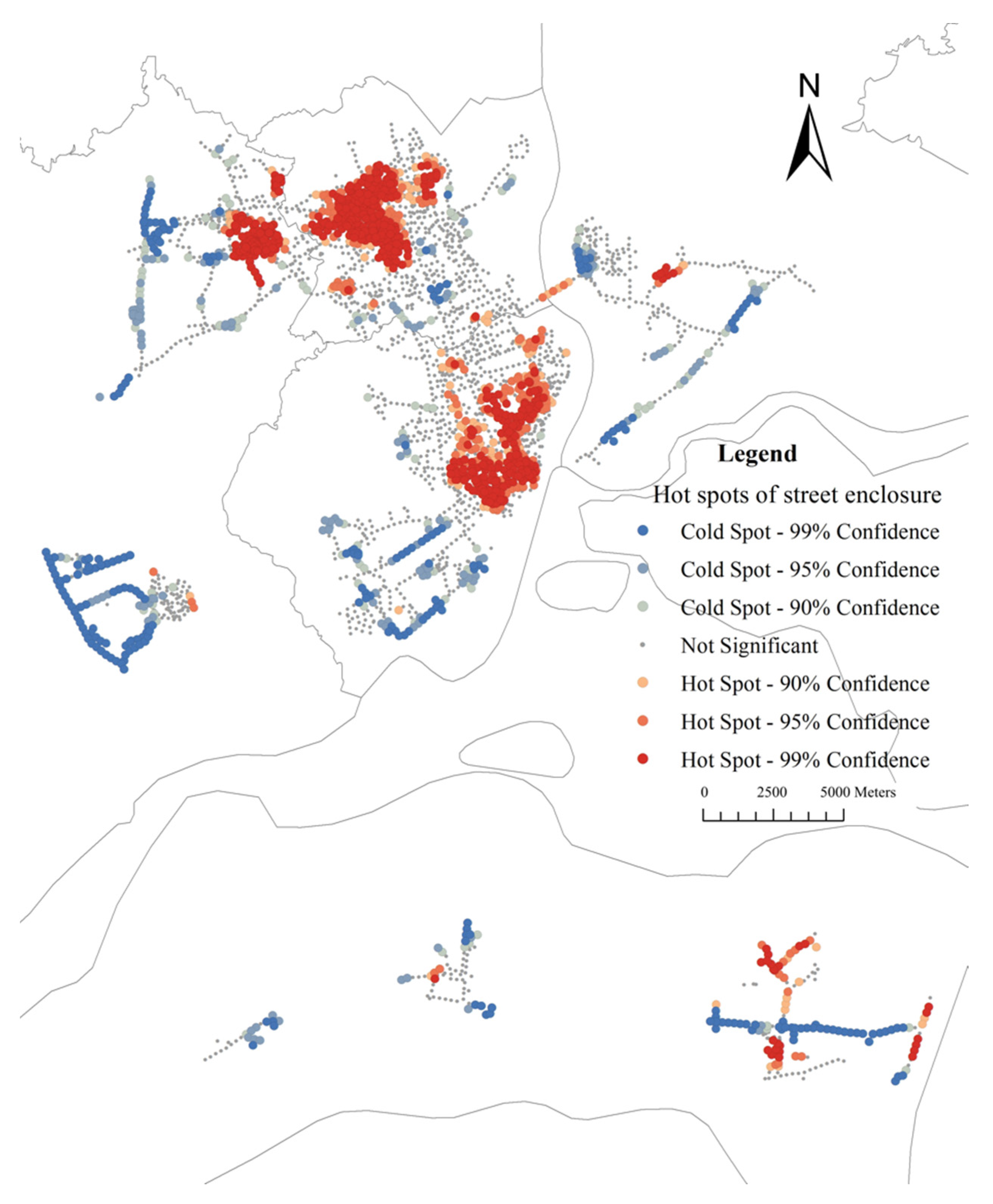
| Buffer Distance (Meter) | ||||||
|---|---|---|---|---|---|---|
| 200 | 500 | 750 | 1000 | |||
| whole patient | number of samples | 211 | 160 | 127 | 112 | |
| GVI | maximum | 35.66 | 35.03 | 23.17 | 17.05 | |
| minimum | 0.00 | 0.60 | 0.09 | 0.39 | ||
| mean | 6.28 | 6.83 | 6.24 | 6.33 | ||
| median | 4.01 | 5.75 | 5.22 | 5.67 | ||
| street enclosure | maximum | 91.89 | 78.76 | 73.98 | 70.34 | |
| minimum | 32.16 | 30.90 | 32.24 | 30.94 | ||
| mean | 60.25 | 57.52 | 55.41 | 54.56 | ||
| median | 59.24 | 58.14 | 56.68 | 54.77 | ||
| number of patients | maximum | 8 | 13 | 28 | 39 | |
| minimum | 1 | 1 | 1 | 1 | ||
| mean | 1.64 | 2.73 | 3.60 | 4.05 | ||
| median | 1 | 2 | 2 | 2 | ||
| patients aged 11–30 | number of samples | 82 | 86 | 71 | 71 | |
| GVI | maximum | 29.70 | 19.88 | 23.17 | 14.83 | |
| minimum | 0.00 | 0.60 | 0.09 | 0.39 | ||
| mean | 6.22 | 6.51 | 6.39 | 6.21 | ||
| median | 3.41 | 5.97 | 5.33 | 5.78 | ||
| street enclosure | maximum | 90.78 | 78.76 | 73.98 | 70.34 | |
| minimum | 32.16 | 31.99 | 33.44 | 30.94 | ||
| mean | 61.19 | 57.56 | 56.38 | 54.92 | ||
| median | 60.84 | 57.20 | 57.20 | 56.72 | ||
| number of patients | maximum | 5 | 5 | 8 | 12 | |
| minimum | 1 | 1 | 1 | 1 | ||
| mean | 1.46 | 1.73 | 2.14 | 2.24 | ||
| median | 1 | 1 | 2 | 2 | ||
| patients aged 31–50 | number of samples | 94 | 88 | 79 | 63 | |
| GVI | maximum | 35.66 | 35.03 | 15.75 | 16.23 | |
| minimum | 0.00 | 0.60 | 0.73 | 0.39 | ||
| mean | 6.30 | 6.48 | 5.90 | 6.49 | ||
| median | 4.25 | 5.12 | 4.96 | 5.68 | ||
| street enclosure | maximum | 91.89 | 78.76 | 73.98 | 70.34 | |
| minimum | 32.45 | 41.77 | 38.92 | 46.33 | ||
| mean | 60.13 | 59.15 | 57.35 | 57.53 | ||
| median | 58.45 | 58.14 | 57.77 | 57.30 | ||
| number of patients | maximum | 4 | 7 | 12 | 18 | |
| minimum | 1 | 1 | 1 | 1 | ||
| mean | 1.36 | 1.92 | 2.35 | 2.75 | ||
| median | 1 | 1 | 1 | 2 | ||
| patients aged 51–70 | number of samples | 59.00 | 62.00 | 49.00 | 45.00 | |
| GVI | maximum | 31.08 | 29.94 | 20.49 | 17.05 | |
| minimum | 0.00 | 0.98 | 1.09 | 1.66 | ||
| mean | 5.67 | 7.25 | 6.50 | 6.51 | ||
| median | 3.64 | 6.15 | 6.53 | 5.68 | ||
| street enclosure | maximum | 90.01 | 78.76 | 69.03 | 68.73 | |
| minimum | 32.45 | 30.90 | 35.89 | 31.77 | ||
| mean | 59.49 | 59.71 | 58.55 | 56.99 | ||
| median | 59.75 | 61.00 | 58.78 | 59.41 | ||
| number of patients | maximum | 8 | 11 | 12 | 16 | |
| minimum | 1 | 1 | 1 | 1 | ||
| mean | 1.34 | 1.50 | 1.90 | 2.16 | ||
| median | 1 | 1 | 1 | 1 | ||
| patients aged 71–90 | number of samples | 16.00 | 17.00 | 17.00 | 14.00 | |
| GVI | maximum | 27.20 | 78.76 | 10.17 | 13.99 | |
| minimum | 0.00 | 0.98 | 2.81 | 3.85 | ||
| mean | 8.03 | 21.30 | 6.47 | 7.19 | ||
| median | 5.97 | 7.00 | 6.95 | 7.11 | ||
| street enclosure | maximum | 86.52 | 68.37 | 69.03 | 64.83 | |
| minimum | 52.19 | 48.35 | 32.24 | 46.33 | ||
| mean | 64.58 | 59.85 | 57.05 | 57.90 | ||
| median | 63.30 | 58.52 | 60.27 | 58.78 | ||
| number of patients | maximum | 4 | 2 | 4 | 5 | |
| minimum | 1 | 1 | 1 | 1 | ||
| mean | 1.19 | 1.53 | 1.47 | 1.71 | ||
| median | 1 | 2 | 1 | 1 | ||
| Buffer Distance (Meter) | GVI | Street Enclosure |
|---|---|---|
| 200 m | −0.0582 | −0.0088 |
| 500 m | −0.0413 | 0.2484 ** |
| 750 m | 0.014 | 0.3201 ** |
| 1000 m | 0.027 | 0.3906 ** |
| Age | Sex | Street Features | Buffer Distance (m) | |||
|---|---|---|---|---|---|---|
| 200 | 500 | 750 | 1000 | |||
| 11–30 years old | male | GVI | −0.1812 | −0.1745 | −0.1396 | −0.0702 |
| street enclosure | −0.1047 | 0.0343 | 0.1042 | 0.1746 | ||
| female | GVI | 0.0886 | 0.0694 | 0.1369 | 0.2141 | |
| street enclosure | −0.3539 | −0.01 | 0.2238 | 0.2821 | ||
| 31–50 years old | male | GVI | 0.0762 | 0.0896 | 0.0846 | −0.0153 |
| street enclosure | 0.0404 | 0.0494 | 0.2815 * | 0.3936 ** | ||
| female | GVI | −0.1911 | 0.1367 | −0.0459 | −0.0047 | |
| street enclosure | −0.036 | 0.0132 | −0.2354 | 0.1907 | ||
| 51–70 years old | male | GVI | −0.0147 | −0.2487 | −0.1823 | 0.0873 |
| street enclosure | −0.1004 | 0.322 | 0.4852 * | 0.4286 * | ||
| female | GVI | −0.0167 | 0.0091 | 0.0923 | 0.0582 | |
| street enclosure | 0.1042 | 0.1229 | 0.0461 | 0.2714 | ||
| 71–90 years old | male | GVI | NaN | 0.6071 | 0.0614 | 0.1275 |
| street enclosure | NaN | 0.273 | 0.3869 | −0.1129 | ||
| female | GVI | −0.3087 | −0.1526 | −0.5332 | 0.0205 | |
| street enclosure | 0.0775 | 0.5477 | 0.5716 | 0.7057 * | ||
Publisher’s Note: MDPI stays neutral with regard to jurisdictional claims in published maps and institutional affiliations. |
© 2022 by the authors. Licensee MDPI, Basel, Switzerland. This article is an open access article distributed under the terms and conditions of the Creative Commons Attribution (CC BY) license (https://creativecommons.org/licenses/by/4.0/).
Share and Cite
Zhang, A.; Zhai, S.; Liu, X.; Song, G.; Feng, Y. Investigating the Association between Streetscapes and Mental Health in Zhanjiang, China: Using Baidu Street View Images and Deep Learning. Int. J. Environ. Res. Public Health 2022, 19, 16634. https://doi.org/10.3390/ijerph192416634
Zhang A, Zhai S, Liu X, Song G, Feng Y. Investigating the Association between Streetscapes and Mental Health in Zhanjiang, China: Using Baidu Street View Images and Deep Learning. International Journal of Environmental Research and Public Health. 2022; 19(24):16634. https://doi.org/10.3390/ijerph192416634
Chicago/Turabian StyleZhang, Anjing, Shiyan Zhai, Xiaoxiao Liu, Genxin Song, and Yuke Feng. 2022. "Investigating the Association between Streetscapes and Mental Health in Zhanjiang, China: Using Baidu Street View Images and Deep Learning" International Journal of Environmental Research and Public Health 19, no. 24: 16634. https://doi.org/10.3390/ijerph192416634
APA StyleZhang, A., Zhai, S., Liu, X., Song, G., & Feng, Y. (2022). Investigating the Association between Streetscapes and Mental Health in Zhanjiang, China: Using Baidu Street View Images and Deep Learning. International Journal of Environmental Research and Public Health, 19(24), 16634. https://doi.org/10.3390/ijerph192416634







